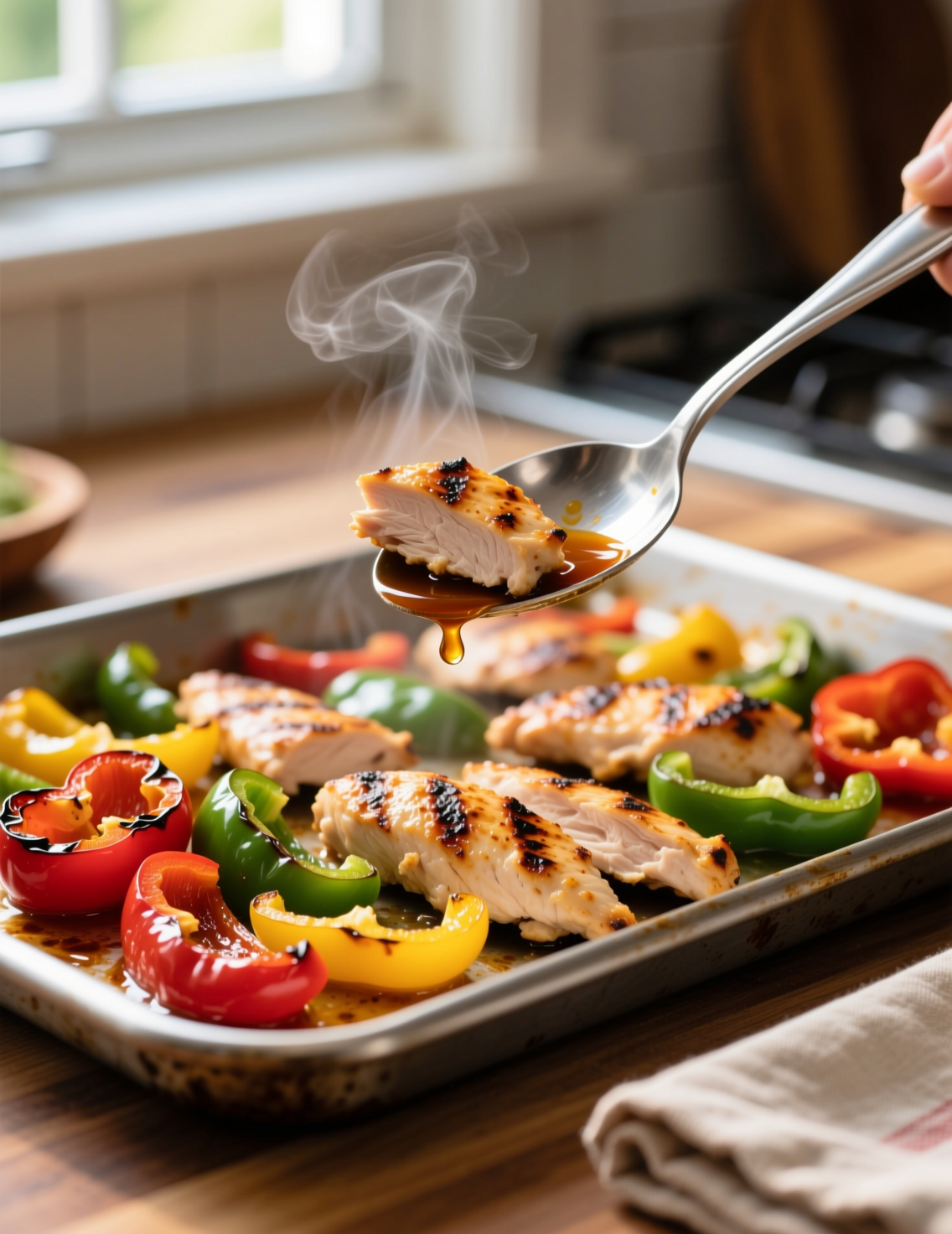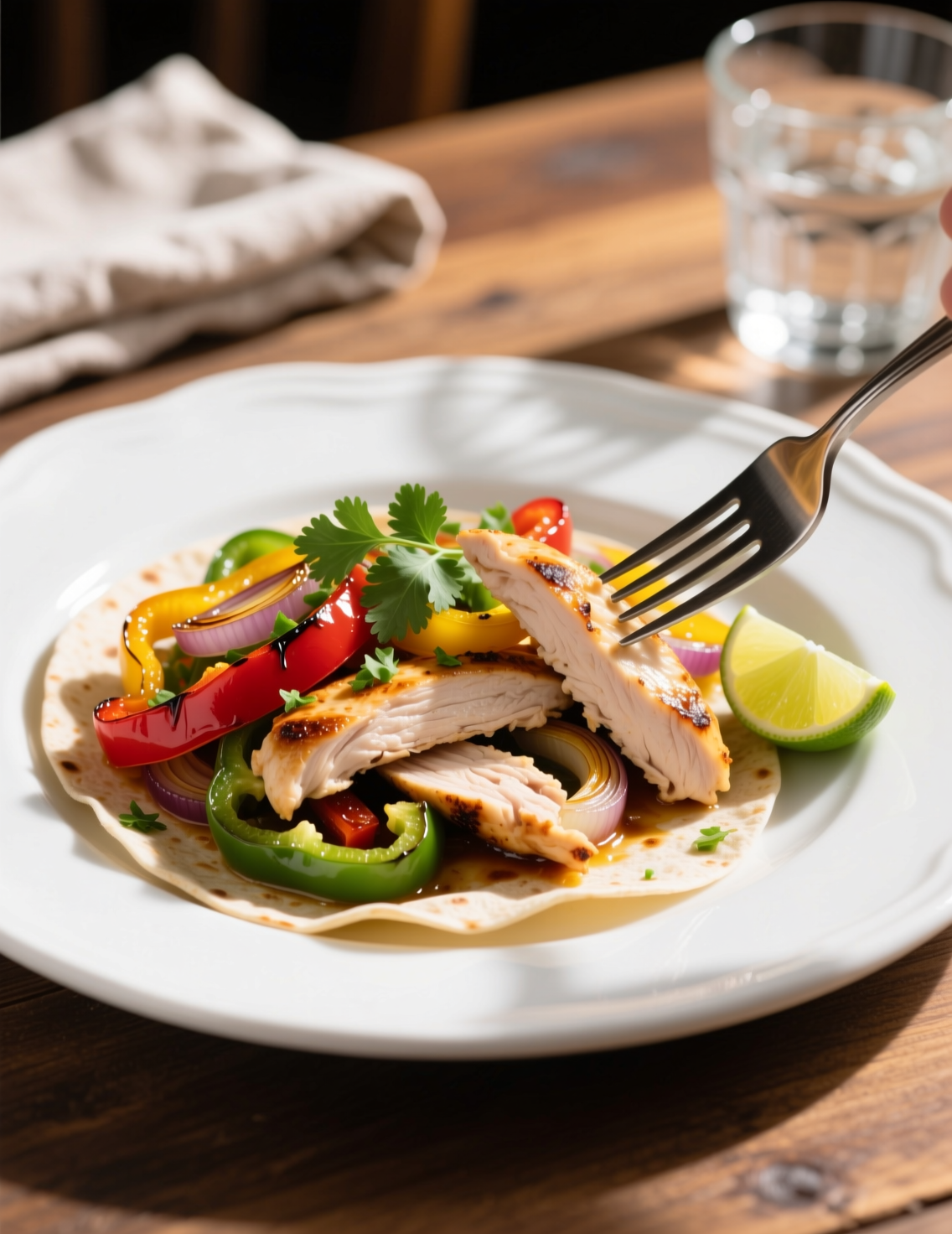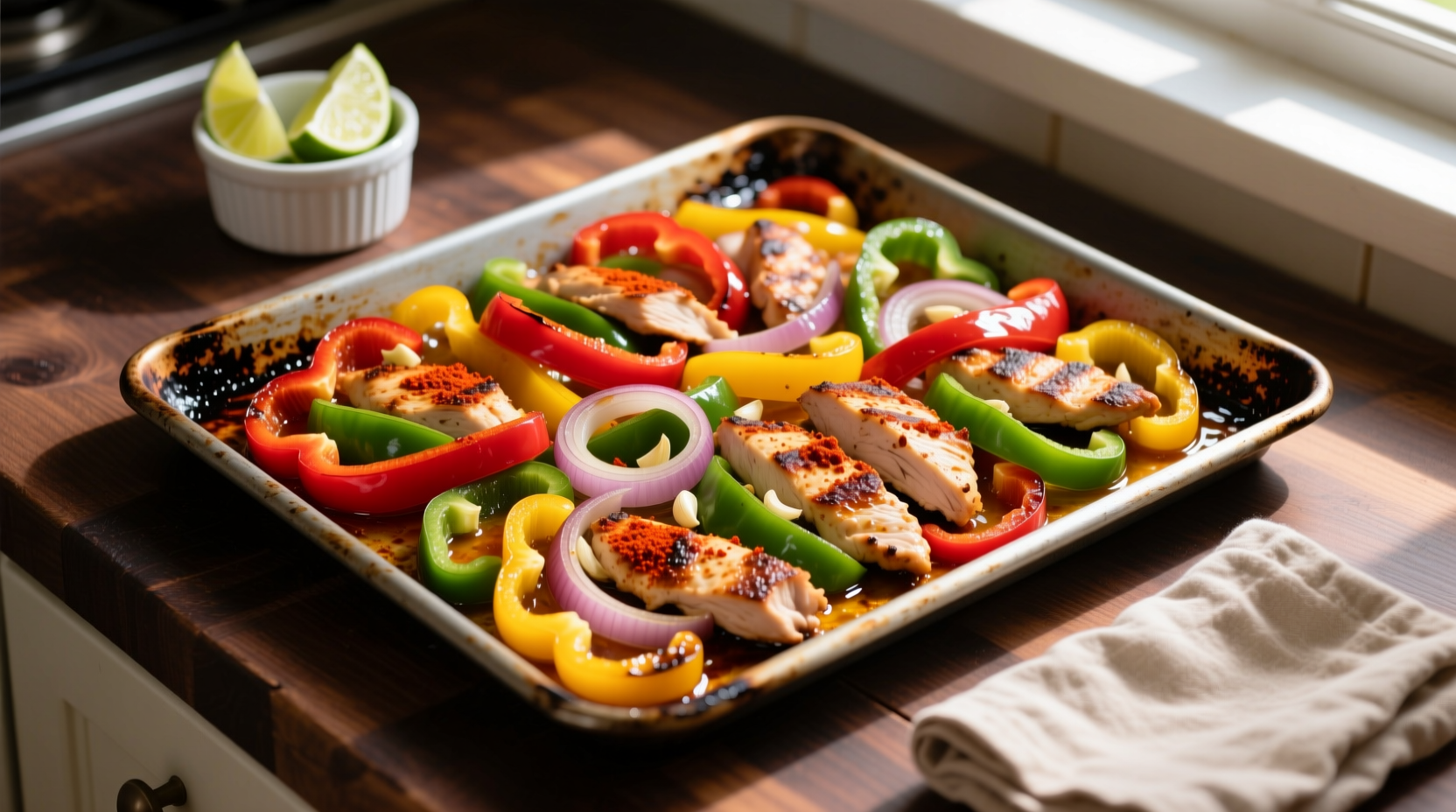Cooking chicken fajitas is nothing new. But the sheet pan method changes the game entirely. If you’ve ever wanted maximum flavor, minimal cleanup, and perfectly cooked chicken with peppers that still snap a little when you bite, this recipe answers the call. The Sheet Pan Chicken Fajitas Recipe for 4 servings is more than a weekday dinner hack—it’s a blueprint for flavor balance, timing precision, and ingredient chemistry.
Why Sheet Pan Fajitas Work So Well
Fajitas traditionally sizzle in cast-iron skillets. That’s how restaurants win us over with sound, smell, and a bit of theater. But at home, the sheet pan offers more control. The wide surface ensures the chicken and vegetables roast evenly, letting heat surround every piece. This creates caramelization you’ll never get in a crowded skillet.
Here’s the kicker: when proteins and vegetables roast side by side, juices mingle. The chicken takes on peppery sweetness while the onions soak in smoky spice. It’s like cross-seasoning built right into the method.
Ingredients That Matter Most
Every sheet pan chicken fajitas recipe starts with the same cast: chicken breast or thighs, bell peppers, onions, and a seasoning blend. But details matter.
Use chicken thighs if you want deeper flavor and insurance against drying out. Breast meat works too, but slice it thicker than you think. Thin strips dry out fast under 425°F heat. Professional kitchens will brine breast meat first—just 20 minutes in salted water—to retain moisture. That’s an overlooked step in most home recipes.
Peppers must be sliced evenly. Thin, but not paper thin. You want them soft around the edges but still carrying crunch in the middle. The colors? Go for a mix—green for bitterness, red for sweetness, yellow for brightness.
Onions bring more than flavor; they contribute moisture. Red onions caramelize faster, while yellow onions mellow with roasting. Mixing them gives depth.
The Science of Marinade
The seasoning is not just about chili powder and cumin. The secret is acid. Lime juice or vinegar in the marinade doesn’t only add tang. It denatures proteins in the chicken’s surface, tenderizing while carrying flavor deep inside.
Olive oil? That’s your conductor. It ensures the dry spices coat every slice, helping them stick during roasting. Studies from the Journal of Food Science show that oil-based marinades can increase spice adhesion by over 30% compared to dry rubs alone. That’s the reason fajitas done this way never taste flat.

Sheet Pan Setup
Preheat the oven to 425°F. That temperature is non-negotiable. Too low and you steam, too high and you char before cooking through.
Line the pan with parchment or foil if you want easy cleanup. But bare metal creates better browning. Professionals often preheat the empty pan for 5 minutes before adding the chicken and veggies. That initial contact sizzles, giving you grill-like sear marks without fire.
Arrange chicken and vegetables in a single layer. Crowding the pan means steaming, not roasting. Two pans may be better than one if you’re scaling up.
Cooking Time Precision
Chicken strips cook fast—around 18–22 minutes at 425°F. But peppers lag behind just slightly. If you want perfection, stagger the additions. Start the peppers and onions for 5 minutes, then add the chicken. But if simplicity matters more, everything can go in together.
Halfway through roasting, stir or flip everything. This exposes new surfaces to the heat and prevents soggy undersides. In professional kitchens, chefs often rotate pans to account for oven hotspots. That same detail at home can mean the difference between evenly roasted fajitas and half-burnt peppers.
Flavor Enhancers That Elevate
Cilantro sprinkled after roasting does more than look pretty. It cuts through the richness with herbal sharpness. Fresh lime squeezed tableside brings volatile citrus oils alive in the steam.
Smoked paprika instead of regular paprika deepens the profile, adding complexity usually reserved for grilled versions. A dash of chipotle in adobo in the marinade? That’s your secret weapon for a smoky undertone.
And don’t skip salt adjustments after roasting. Heat alters perception of saltiness. Always taste before serving and finish with a pinch of flaky salt if needed.
Serving Like a Pro
Fajitas are about assembly. Warm tortillas are non-negotiable. Steam them wrapped in foil in the oven’s last 5 minutes, or better yet, toast them briefly on a dry skillet for charred edges.
Accompaniments matter. Guacamole softens heat. Salsa verde brightens. Sour cream cools the tongue. But don’t overwhelm the fajitas. Each topping should enhance, not mask.
A professional trick: serve on a warmed platter, not straight from the sheet pan. Resting fajitas for 2 minutes lets juices redistribute, preventing soggy tortillas.
Nutritional and Practical Insights
A 4-serving sheet pan chicken fajitas recipe usually runs around 350–400 calories per serving without tortillas and toppings. Protein sits near 30 grams, fat around 14 grams, carbs from vegetables roughly 18 grams. It’s balanced, nutrient-dense, and fits most diets.
From a meal-prep perspective, this recipe stores beautifully. Leftovers reheat best under a broiler for 2 minutes. Microwaving works, but you’ll lose crisp edges. For professionals designing menus, this dish offers a high return: low labor, minimal equipment, scalable to 50 servings without loss of quality.

Common Mistakes to Avoid
One of the biggest errors? Overcrowding. A packed pan equals soggy fajitas. Always leave breathing room.
Another? Cutting chicken too thin. Precision slicing matters as much here as in sushi. Uneven strips give you half-dry, half-undercooked meat.
And marinating too long in citrus is a sleeper mistake. More than 2 hours, and your chicken turns mushy. Acid is powerful—use with care.
Variations for Professionals
Think of the sheet pan method as a framework. You can swap proteins—shrimp cooks in half the time, while flank steak thrives under high heat with a shorter roast. Portobello mushrooms or jackfruit mimic the texture for vegetarian menus.
Seasoning profiles can change cultures entirely. Swap cumin and chili powder for garam masala and turmeric, and suddenly you’re serving sheet pan chicken tikka fajitas. Use soy sauce, sesame oil, and ginger, and you drift toward a teriyaki-style fajita hybrid. The sheet pan doesn’t care—it adapts.
Emerging Trends in Sheet Pan Meals
Food trend reports in the U.S. show a 35% rise in sheet pan recipe searches over the last 3 years. Why? Time economy. Home cooks want maximum impact with minimal mess. Restaurants have started to mimic this by offering roasted fajita trays for catering.
Plant-forward adaptations are gaining steam too. Professionals now roast cauliflower steaks with fajita seasoning, pairing them with the same tortillas and toppings. It’s not a fad—it’s a shift in how we think of fajitas as flexible rather than fixed.
Expert-Level Tips Few Talk About
Dust the chicken lightly with cornstarch before tossing in oil and seasoning. It encourages browning by absorbing surface moisture, giving a crisp edge.
Rest the chicken strips uncovered for 5 minutes after slicing raw. This air-dries the surface, which enhances browning later.
And here’s one more: place lime wedges directly on the sheet pan during roasting. Heat caramelizes the juice, giving you a smoky-sweet lime squeeze at the table. It’s a tiny move with oversized payoff.
The Recipe (4 Servings)
Ingredients
- 1.5 pounds boneless chicken thighs or breasts, sliced into strips
- 3 bell peppers (red, yellow, green), sliced into strips
- 1 large onion (red or yellow), sliced
- 3 tbsp olive oil
- Juice of 1 lime
- 1 tsp chili powder
- 1 tsp smoked paprika
- 1 tsp cumin
- ½ tsp garlic powder
- ½ tsp onion powder
- ½ tsp oregano
- 1 tsp salt (adjust after roasting)
- ½ tsp black pepper
- Warm tortillas, for serving
- Cilantro and extra lime wedges, for garnish
Method
- Preheat oven to 425°F.
- In a large bowl, combine oil, lime juice, and all spices. Toss chicken strips until coated. Add peppers and onions, tossing again.
- Spread mixture on a sheet pan in a single layer.
- Roast for 18–22 minutes, stirring once halfway.
- Taste, adjust salt, and garnish with cilantro. Serve with warm tortillas and toppings.
Wrapping It Up
The Sheet Pan Chicken Fajitas Recipe for 4 servings is not just weeknight cooking—it’s culinary efficiency done right. Professionals and home cooks alike can appreciate its balance of bold flavor, simple execution, and smart technique.
The key takeaways? Don’t crowd the pan, use acid wisely, cut vegetables with precision, and finish with freshness. With those in hand, you’ll produce fajitas that taste like restaurant quality but with less effort, less mess, and all the joy of cooking made simpler.
FAQs
What’s the best chicken cut for sheet pan fajitas?
Chicken thighs stay juicy; breasts work if sliced thick and brined.
Can I use other vegetables besides bell peppers?
Yes, onions, mushrooms, or zucchini work well.
Do I need to marinate the chicken?
Yes, even 20 minutes enhances flavor and tenderness.
What oven temperature is ideal?
425°F ensures even roasting and caramelization.
How long should I roast the fajitas?
Around 18–22 minutes, stirring halfway.
Can I make this recipe for more than 4 servings?
Yes, just use multiple sheet pans to avoid overcrowding.
Should I cover the sheet pan?
No, roasting uncovered gives better browning.
Can I prep this recipe ahead of time?
Yes, marinate chicken and slice veggies a few hours early.
How do I keep tortillas warm?
Wrap in foil and heat in the oven or toast briefly on a skillet.
Can this recipe be made vegetarian?
Yes, substitute chicken with tofu, mushrooms, or cauliflower.
What’s the secret to crispy edges on chicken?
Lightly dust with cornstarch and roast uncovered.
Should I add toppings before or after roasting?
Always add fresh toppings like cilantro and lime after roasting.
How do I prevent vegetables from being soggy?
Slice evenly and avoid overcrowding the pan.
Can I use a broiler for faster cooking?
Yes, but watch closely to prevent burning.
Are leftovers still good?
Yes, reheat under a broiler to keep edges crisp.

Mariana is a passionate home cook who creates delicious, easy-to-follow recipes for busy people. From energizing breakfasts to satisfying dinners and indulgent desserts, her dishes are designed to fuel both your body and hustle.
When she’s not in the kitchen, she’s exploring new flavors and dreaming up her next recipe to share with the Foodie Hustle community.

